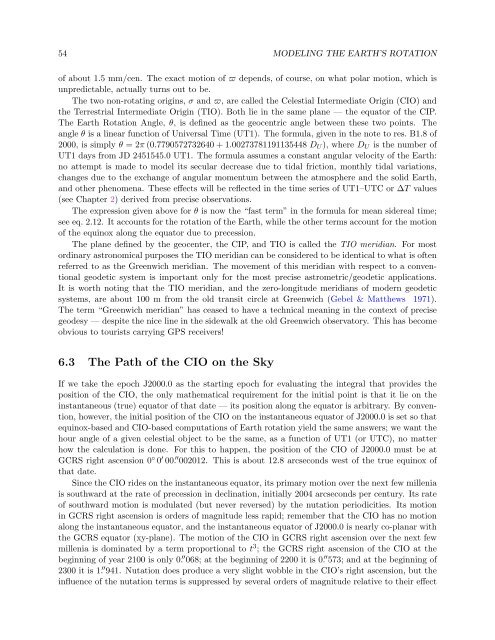USNO Circular 179 - U.S. Naval Observatory
USNO Circular 179 - U.S. Naval Observatory
USNO Circular 179 - U.S. Naval Observatory
Create successful ePaper yourself
Turn your PDF publications into a flip-book with our unique Google optimized e-Paper software.
54 MODELING THE EARTH’S ROTATION<br />
of about 1.5 mm/cen. The exact motion of ϖ depends, of course, on what polar motion, which is<br />
unpredictable, actually turns out to be.<br />
The two non-rotating origins, σ and ϖ, are called the Celestial Intermediate Origin (CIO) and<br />
the Terrestrial Intermediate Origin (TIO). Both lie in the same plane — the equator of the CIP.<br />
The Earth Rotation Angle, θ, is defined as the geocentric angle between these two points. The<br />
angle θ is a linear function of Universal Time (UT1). The formula, given in the note to res. B1.8 of<br />
2000, is simply θ = 2π (0.7790572732640 + 1.00273781191135448 DU), where DU is the number of<br />
UT1 days from JD 2451545.0 UT1. The formula assumes a constant angular velocity of the Earth:<br />
no attempt is made to model its secular decrease due to tidal friction, monthly tidal variations,<br />
changes due to the exchange of angular momentum between the atmosphere and the solid Earth,<br />
and other phenomena. These effects will be reflected in the time series of UT1–UTC or ∆T values<br />
(see Chapter 2) derived from precise observations.<br />
The expression given above for θ is now the “fast term” in the formula for mean sidereal time;<br />
see eq. 2.12. It accounts for the rotation of the Earth, while the other terms account for the motion<br />
of the equinox along the equator due to precession.<br />
The plane defined by the geocenter, the CIP, and TIO is called the TIO meridian. For most<br />
ordinary astronomical purposes the TIO meridian can be considered to be identical to what is often<br />
referred to as the Greenwich meridian. The movement of this meridian with respect to a conventional<br />
geodetic system is important only for the most precise astrometric/geodetic applications.<br />
It is worth noting that the TIO meridian, and the zero-longitude meridians of modern geodetic<br />
systems, are about 100 m from the old transit circle at Greenwich (Gebel & Matthews 1971).<br />
The term “Greenwich meridian” has ceased to have a technical meaning in the context of precise<br />
geodesy — despite the nice line in the sidewalk at the old Greenwich observatory. This has become<br />
obvious to tourists carrying GPS receivers!<br />
6.3 The Path of the CIO on the Sky<br />
If we take the epoch J2000.0 as the starting epoch for evaluating the integral that provides the<br />
position of the CIO, the only mathematical requirement for the initial point is that it lie on the<br />
instantaneous (true) equator of that date — its position along the equator is arbitrary. By convention,<br />
however, the initial position of the CIO on the instantaneous equator of J2000.0 is set so that<br />
equinox-based and CIO-based computations of Earth rotation yield the same answers; we want the<br />
hour angle of a given celestial object to be the same, as a function of UT1 (or UTC), no matter<br />
how the calculation is done. For this to happen, the position of the CIO of J2000.0 must be at<br />
GCRS right ascension 0 ◦ 0 ′ 00. ′′ 002012. This is about 12.8 arcseconds west of the true equinox of<br />
that date.<br />
Since the CIO rides on the instantaneous equator, its primary motion over the next few millenia<br />
is southward at the rate of precession in declination, initially 2004 arcseconds per century. Its rate<br />
of southward motion is modulated (but never reversed) by the nutation periodicities. Its motion<br />
in GCRS right ascension is orders of magnitude less rapid; remember that the CIO has no motion<br />
along the instantaneous equator, and the instantaneous equator of J2000.0 is nearly co-planar with<br />
the GCRS equator (xy-plane). The motion of the CIO in GCRS right ascension over the next few<br />
millenia is dominated by a term proportional to t 3 ; the GCRS right ascension of the CIO at the<br />
beginning of year 2100 is only 0. ′′ 068; at the beginning of 2200 it is 0. ′′ 573; and at the beginning of<br />
2300 it is 1. ′′ 941. Nutation does produce a very slight wobble in the CIO’s right ascension, but the<br />
influence of the nutation terms is suppressed by several orders of magnitude relative to their effect


